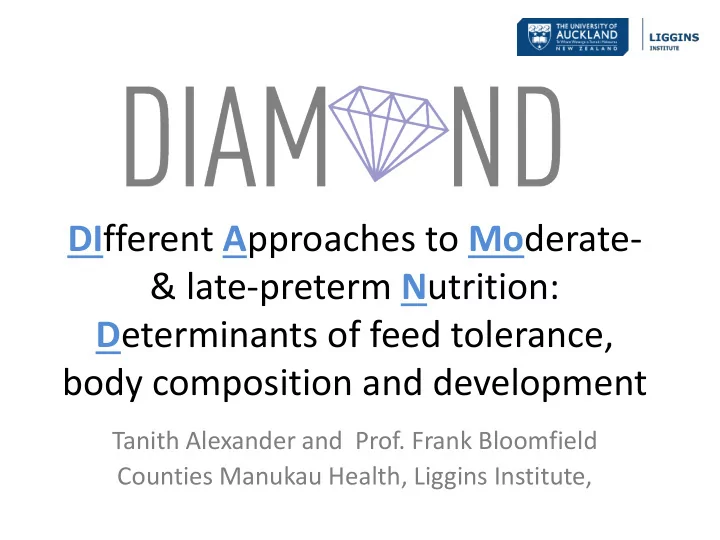

DI fferent A pproaches to Mo derate- & late-preterm N utrition: D eterminants of feed tolerance, body composition and development Tanith Alexander and Prof. Frank Bloomfield Counties Manukau Health, Liggins Institute,
Background • ~ 5000 preterm babies born in NZ each year • > 80% are moderate to late preterm (MLPT) • MLPT babies are the “great dissemblers” • Look like term babies, behave well, excellent short- term outcomes • BUT: • MLPT babies have increased morbidity and mortality in the first 3 years • Increased risk of developmental delay, behavioural problems and special education needs • Increased risk of obesity, hypertension and diabetes in adulthood 2
Background • Why are they are increased risk of neurodisability and non-communicable disease? • have 50% greater body fat than term controls by term- corrected age • Often have period of poor nutrition after birth whilst waiting for full feeds with mother’s milk • Nutrition during this time not regulated by mother or baby • Microbiome being established at this critical time and may be different from that in term babies • No clinical evidence to base practice • No clinical guidelines 3
Aims Investigate the impact of different feeding strategies currently used in NZ, on feed tolerance, body composition, gut microbial composition and developmental outcome in moderate to late preterm infants
• Trial design: Multi-site, randomised, factorial design, clinical trial • Participants: Babies 32 +0 – 35 +6 weeks gestation, whose Mother’s intend to breastfeed, admitted to NNU/SCBU, requiring IV insertion for clinical reasons
• Exclusion criteria: • Babies in whom a particular mode of nutrition is clinically indicated • Babies with a congenital abnormality
Factorial Design Study • Assess the effect of each intervention separately whilst exploring the effects of their interactions • Evaluate several interventions vs. the control in a single experiment • Efficient and economical • Useful complement to the RCT Collins L, et al. Am Journal of Preventative Medicine. 2014
Parenteral nutrition Milk supplement Taste/Smell + + + - - - • 3 independent variable or factors • Babies randomised to receive or not receive each of the three factors • D10% vs Amino acid solution (P100) • Infant formula vs wait for breastmilk • Taste/smell vs standard protocol
Primary Outcomes • Factors i and ii • Body composition assessment at 4 months’ corrected age when infant adiposity is predictive of childhood fat mass measured by air displacement plethysmography (ADP) or skin fold thickness measurements • Factor iii • Time to full enteral feeds
Secondary Outcomes • Length of hospital stay • Days to full suck feeds • Developmental assessment • Breastfeeding rates • Breastmilk composition • Hormone concentrations in saliva • Gut microbiome composition and activity • Nutritional intake
Sample Size • Estimate based on 90% power • Overall type 1 error rate of 5%, alpha per main effect = 0.0167 • 10-15% loss to follow-up Fat mass at 4 months of age • To detect a 3% difference in % fat mass (95% CI) • N = 280 (140 babies in each of the intervention arms: D10% vs P100)
Sample Size Time to full enteral feeds • To decrease time to full enteral feeds from 10 to 7 days (hazard ratio 1.43) • N = 530 (265 babies in each intervention arm)
Sample Size • Powered to detect a decrease in the proportion of 2 year olds surviving free from neurodisability from 80% to 70%. • Randomisation: Stratified by gestation (32 +0 to 33 +6 , 34 +0 – 35 +6 ), site and sex
Impact and Outcome • Decrease length of stay – Cost saving: $3 million/year • Decrease rates of obesity in this at risk group • Enable us to develop a package of care • Provide high quality research on which to base clinical practice • Translation into practice, quick and easy to implement nutritional guidelines
Research Team Professor Frank Bloomfield Professor Jane Harding Dr Jane Alsweiler Dr Michael Meyer Dr Yannan Jiang Dr Clare Wall
Recommend
More recommend